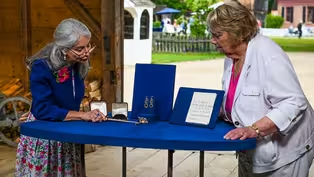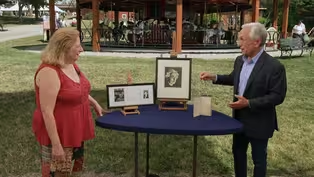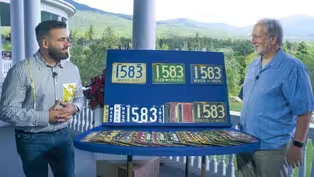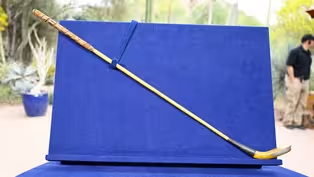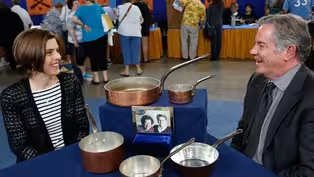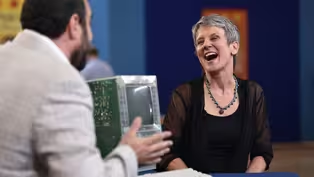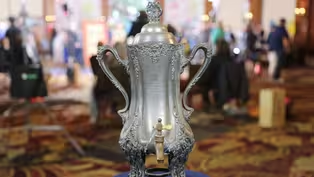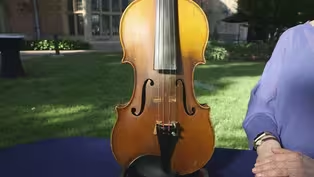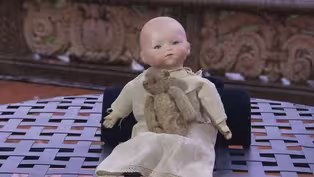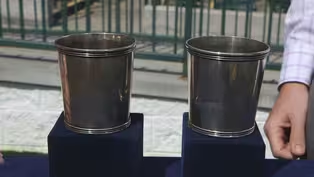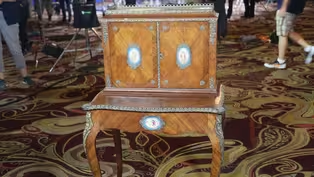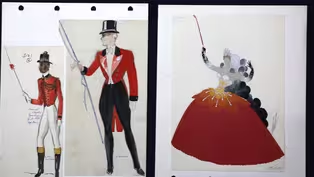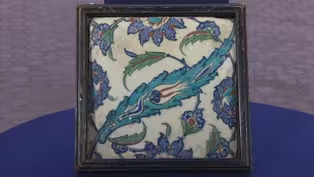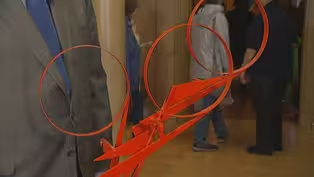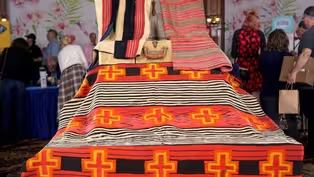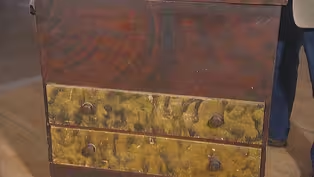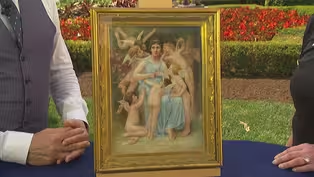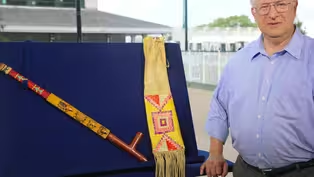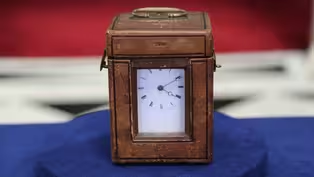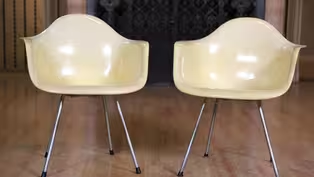
Junk in the Trunk 9
Season 23 Episode 26 | 52m 29sVideo has Closed Captions
Discover never-before-seen appraisals from all Season 23 cities, like a $40K-$60K find!
Discover never-before-seen appraisals from all five Season 23 cities, including 1949 Charles & Ray Eames molded chairs, a Sioux pipe and pipe bag made around 1880, and a 1953 MAD Issue 8 “Frank N. Stein” story. Which is valued at $40,000-$60,000?
Problems playing video? | Closed Captioning Feedback
Problems playing video? | Closed Captioning Feedback
Funding for ANTIQUES ROADSHOW is provided by Ancestry and American Cruise Lines. Additional funding is provided by public television viewers.

Junk in the Trunk 9
Season 23 Episode 26 | 52m 29sVideo has Closed Captions
Discover never-before-seen appraisals from all five Season 23 cities, including 1949 Charles & Ray Eames molded chairs, a Sioux pipe and pipe bag made around 1880, and a 1953 MAD Issue 8 “Frank N. Stein” story. Which is valued at $40,000-$60,000?
Problems playing video? | Closed Captioning Feedback
How to Watch Antiques Roadshow
Antiques Roadshow is available to stream on pbs.org and the free PBS App, available on iPhone, Apple TV, Android TV, Android smartphones, Amazon Fire TV, Amazon Fire Tablet, Roku, Samsung Smart TV, and Vizio.
Buy Now
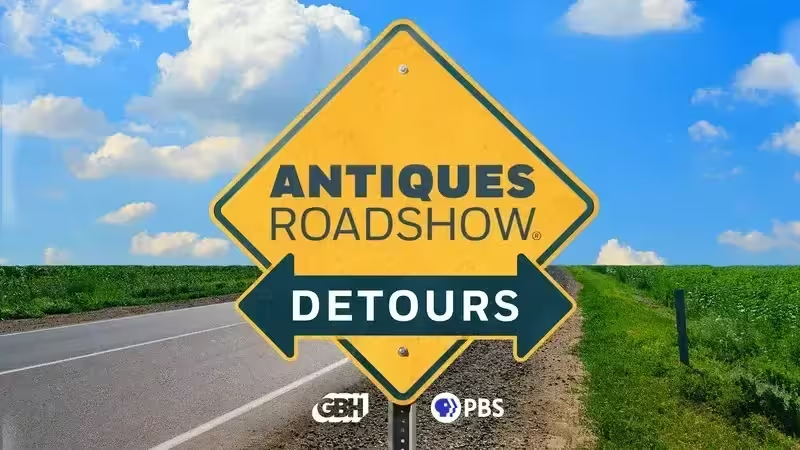
ANTIQUES ROADSHOW DETOURS
Ever wondered what happens to the treasures featured on America’s beloved ANTIQUES ROADSHOW after the cameras leave town? Host Adam Monahan tracks down the juicy afterlives of your favorite finds from PBS’s hit series.Providing Support for PBS.org
Learn Moreabout PBS online sponsorshipMore from This Collection
Check out all of our Junk in the Trunk specials!
Video has Closed Captions
Travel to all five cities of ROADSHOW's Season 28 Tour for never-before-seen appraisals! (52m 25s)
Video has Closed Captions
Catch a trunkful of never-before-seen treasures from ROADSHOW's season 27 tour. (52m 26s)
Video has Closed Captions
Discover all new appraisals from ROADSHOW’s Season 26 tour, like a find of up to $75,000! (52m 27s)
Video has Closed Captions
Discover never-before-seen surprises from our Season 24 tour. One is worth up to $100K! (52m 45s)
Video has Closed Captions
ROADSHOW’s bigger-than-ever 2014 season includes a second hour of junk! (53m 10s)
Video has Closed Captions
Discover more previously unseen appraisals from our eight-city tour. (53m 10s)
Providing Support for PBS.org
Learn Moreabout PBS online sponsorshipMARK WALBERG: If you think you've seen all the treasures from "Antiques Roadshow's" 23rd season, think again.
I literally felt my heart almost jump out of my chest.
WALBERG: More terrific stuff coming up in this season's special episode of "Antiques Roadshow: Junk in the Trunk."
♪ ♪ WALBERG: "Roadshow" began this season's tour in Sarasota, Florida, at the former home of John and Mable Ringling, Ca' d'Zan.
There were no circus clowns or high-flying acts, but there was one similarity: eager crowds ready to be amazed.
Well, what you brought in today was a railroad watch.
Okay.
And it was made by the Elgin Watch Company.
What's really special about your watch is that you brought the box with it.
Your watch by itself would probably be worth about $100, because they made a lot of these.
Okay.
But the box and watch as a combination has a value of about $350.
Ooh.
Because you have the original box.
Holy... (laughing): Holy mackerel.
I have a Civil War revolver, canteen, bullets, money.
It's all a collection my grandfather started and I continued.
General rule of thumb is, the less it looks like a conventional typewriter, the more kind of appealing it might be.
This is somewhere, at auction, around $1,500 to $2,000.
Wow.
So, pretty cool-- pretty cool typewriter.
Yeah, very cool.
Glad you brought it in.
Thank you very much.
MAN: Well, this is a Selmer Mark VI, and I bought it my freshman year at college.
I bought it in New York City.
I had started a band my senior year in high school, and carried that through college.
I bought it in the fall of '64 and I paid $365.
It's a Selmer Mark VI alto saxophone, made in Paris.
The serial number dates it to about the middle of 1964.
Vintage horns such as this are more desirable than even the best horns that are made today.
A Selmer Mark VI from the 1960s is kind of the holy grail of the saxophone.
Oh, wow.
The condition is spectacularly good.
This horn is 99-plus-percent original lacquer, which is hard to find.
In today's market, this horn would sell for $6,000, at least.
Wow.
And you've got three mouthpieces here: a Brilhart metal-- duck bill, we call that...
Right, right.
The original Selmer C Star hard rubber... Yep, yep, yep.
And another Brilhart that happens-- this is the tenor mouthpiece.
Yeah, that was the tenor.
Sometimes I would play tenor.
Between the three of them, there's probably about $700 worth of vintage mouthpieces.
Wow, wow.
And the total value of the whole package is about $6,700 at retail.
Very nice.
Thank you for bringing it in.
Appreciate it.
MAN: My father was city editor at the "Boston Herald" at the time of some segregation issues in the city of Boston.
He assigned Stanley Forman to a photography shoot at a demonstration.
This picture is one that Stanley took as a consequence of an altercation in front of the City Hall.
It won a Pulitzer Prize.
He won two Pulitzer Prizes, and both times he was assigned to take the photographs by my father.
I'm very proud of that.
Well, this photo is one of the iconic photographs of America, of the Civil Rights Movement.
It was taken in April of 1976.
It depicts racial conflict in Boston around the school busing issue.
This is Boston City Hall Plaza.
There had just been a rally with a Boston city councilor named Louise Day Hicks, who didn't want busing.
Didn't want to integrate the schools at all.
Correct.
And she had riled the crowd up.
Yes.
So they had, sort of coming out of the City Hall and they were heading towards the federal courthouse to protest there.
The man in the photograph, his name is Ted Landsmark.
Mm-hmm.
And he just happened to be going to a meeting.
He was also, happened to be a civil rights lawyer.
One of the protesters picked up the American flag and ran at him with it.
Stanley captured it.
Now, the title of this photograph is "Soiling of Old Glory."
Correct.
Ted Landsmark ended up having his nose broken.
The police pulled him out of there.
Once this image appeared, and it went nationwide, then people started taking a lot more note, and it really pushed people to really start dealing with it.
It was a terrible scene in Boston.
It's an absolutely fabulous photo.
I have not seen many signed copies turn up, but I would say conservatively, on a retail basis, $2,000 to $3,000.
Really?
Really.
I mean, it's such an iconic photo, it's fabulous.
I appreciate it, thank you very much.
(people talking in background) APPRAISER: When did you acquire this collection?
MAN: That would be... 1978.
APPRAISER: The artist, Romain de Tirtoff, was a Russian who studied in Paris.
He went by the name Erté.
And in fact, this work is signed "Erté."
He became one of the iconic designers of the 1920s and '30s.
These are the most iconic examples of his work.
This is a collection of Erté costume designs for the Ringling Brothers Circus.
MAN: That's correct.
APPRAISER: You have these wonderful sketches, as well as these highly finished, highly detailed drawings.
You have about ten fully finished ones, like our ringleader lady here.
And you have about 15 of the smaller sketches.
They're in excellent condition.
The smaller ones tend to sell for about $1,500.
The larger ones go for between $3,000 and $5,000.
I think that because of the circus interest, the total collection would be more like $50,000 to $60,000.
That isn't what I paid for them.
It isn't?
(chuckling): No.
Was it less or more?
Much, much less.
$50 or $60, something like that.
APPRAISER: For the whole collection?
MAN: Yes, mm-hmm.
APPRAISER: Wow.
WOMAN: The clock belonged to my great-uncle, and he sent it to my mother before he died, saying that it had great value.
And all we know about it is that it is a French carriage clock.
He was a collector of many different antiquities, mostly barometers.
He had a huge barometer collection, so I don't know if it was acquired somehow through... APPRAISER: Right.
...a dealer with that, I'm not sure.
Did he have other clocks, as well, or...?
No, not that he felt had the same value that this one did.
Right.
He sent it to my mother about 40 years ago.
Right.
This is a French carriage clock.
One of the great things about it is that it has its original carrying case.
Yes.
And they also are referred to as travel clocks, because it's a clock that has a balanced spring mechanism in it, so it can travel without losing time.
Like, a clock with a pendulum would need to be stable on a table.
Right.
And couldn't go over a bump without stopping.
Sure.
This is a fantastic original leather case, and they almost never hold up into this condition.
Even has its original buckles on each side, brass buckles, and then it has a nice original brass handle that hasn't pulled off the top, which is really unusual.
But this opens up, and the clock comes out.
This clock is made circa 1890, and it's unsigned, but I do know that it's of French origin.
And it's in a spectacular case.
The case is called a gorge case, and it refers to these convex and concave moldings that you see around the case.
Oh, okay.
And then this double-tiered top, which is another feature, and then the five divisions on the handle is another feature of a gorge case.
Some of the finest carriage clocks were found in gorge cases like this.
Oh, okay.
Also, another great feature is this white enamel dial.
It's in perfect condition, it looks like the day it was made.
Yes.
And that's a nice feature.
Also, at the top, there's what we call an hour repeat button.
So if this were at your bedside circa 1890, and you didn't want to light a candle, you could just reach over, press the button, and you would get the last hour that was struck.
So it wouldn't tell you 2:30, but it would tell you that it was some time after 2:00 if it struck twice.
Oh, wow-- wow.
It's not overly complicated in terms of its complications-- it's just time and strike.
In a lot of these clocks, what really drive price are added complications, like alarms and petite sonneries, and different type of striking functions.
Just a wonderful piece to have.
A clock like this would sell in a retail shop anywhere from $1,500 to $1,800.
Oh, my gosh, that's incredible.
Yeah, yeah.
That's incredible.
Wow.
Beautiful piece.
We love it.
WALBERG: In Tulsa, Oklahoma, "Roadshow" fans showed their enthusiasm for the objects they brought to the Philbrook Museum of Art through sunshine and rain.
APPRAISER: It does say "G.E.R.
silver" on it, for German silver.
German silver was a name used to describe an alloy of metals that was created to imitate silver.
Value-wise?
Not a huge amount.
But it is an antique object.
You're looking at something that's 120, 130 years old.
Wow, 120 years old?
Yeah, yeah.
That's crazy.
These are wonderful little miniature lacrosse sticks from the New York area.
Mm-hmm.
We know a lot of Native Americans came down in here to Oklahoma.
I think they have a modest value.
For the pair, maybe $40 to $60.
Okay.
MAN: I think the Eames chair's from, like, 1960s or so.
My grandma gave them to me when she was getting older and moving into an assisted living home.
They wouldn't fit in my car-- it's a small coupe-- and I was trying to throw them away, and my fiancé, luckily, said, "I'll take them apart and put them in my car," and so I brought them home and they've just kind of been sitting in my studio.
(laughing): My grandma paid five dollars for them.
That's great.
And your grandma's the original owner?
Yes-- well, she... No, she bought them from the Knights of Columbus.
Which, they had-- they were getting rid of them all.
Any sense of the time when that happened?
Uh, I think she said in the '60s.
You know, I've-- they've been around my whole life.
I'm 42, she's 95, so... And I remember these chairs at her house.
So they are by Charles and Ray Eames.
They're a little earlier than you think, they're 1949.
Oh, wow.
So the design came about in 1947.
It was a MoMA design competition.
It was about good quality, modern design, and low expense.
So, cheap furniture for the masses but great quality.
What makes these chairs special is that they really are from 1949.
Really the earliest iteration of this chair.
Some of the features that show us that the chair is an early version-- the first generation, really... Uh-huh.
...start at the bottom.
When we look at the underside of the chair, we see the early label.
This was a Herman Miller-Zenith Plastics collaboration in 1949.
What was great about this chair and why it became an award-winning design was the modularity.
These pucks here, that we refer to as shock mounts, would allow the base to be taken off and interchanged with a host of bases.
This chair is called the D.A.X.
chair.
Other features of the earliest chair are the rope edge embedded in the plastic-reinforced fiberglass.
Another feature of the chair that changed almost immediately was the colors.
Only the first generation or so had this translucent quality, and I'd like to show you what I mean.
Okay.
I'm taking out a flashlight here; if we had a sunny day, you'd be able to see this without a flashlight.
But you'll see here a little bit of transparency.
Uh-huh.
In the grain.
And almost immediately, that was changed in the latter generations, because they went to darker colors.
This color was called parchment.
In 1949, no one had ever made a chair of fiberglass, so this was really innovative.
Many of the chairs that we see today, they have condition issues.
Yeah.
They have what they call bleed-through.
So where that shock mount is glued to the bottom, the resin interacts with the plastic and it stains it.
Yeah.
So these chairs are actually in really great shape.
Now, I did notice that of the two chairs, this one here has a crack.
That affects how collectors appreciate the chair.
However, you should be pleased that you didn't put them to the trash.
(chuckles) Do you have any sense of the value?
Uh, you know, I looked...
I didn't know how, I thought they were, you know, $500 to $1,000.
You know, something in that range, that's when I thought I should probably keep them, at that point, so...
Uh, you're pretty close.
Okay.
They're a little bit more.
Okay.
Even though there's a crack there.
Had they been in perfect shape, the auction value would have been about $2,000.
Uh-huh.
Now, due to the crack here... Uh-huh.
We're closer to about $1,500 for the pair.
Wow, cool-- not bad for five bucks.
WOMAN: I'm a member of the Muscogee Nation, and these are the original documents from my grandmother and grandfather on my father's side, of their allotted land for Indian Territory.
Each received 160 acres.
This is on the Verdigris River, between Wagoner and Coweta.
APPRAISER: Not too far from here.
Not too far, about 30 minutes.
Right.
We still own my grandmother's allotted land.
It's in our family still, with the original house still on it.
At the time, every citizen that was on the Dawes Rolls was able to get 160 acres per person.
My grandfather and grandmother and their eldest living child, she received it at the age of two.
But I only have the documents for my grandmother and grandfather.
And why are they different dates?
1905 and 1903?
Well, they were consecutive in their roll numbers.
That's their roll numbers for our tribe.
Right.
And down here is when they were signed by Pleasant Porter, our chief at that time, and then at the Bureau of Indian Affairs, gave the allotments to my grandparents.
We've seen others of these today, but never a consecutive number.
They're both in very good condition, with the exception that the 1921 document suffered some water damage.
But I see you've had them nicely preserved, you said in a book?
They were found in a book, yes.
And that's helped them extremely, because they are in absolutely fresh original condition.
My colleagues and I both thought that you should probably have an insurance value of around $500 on each of them.
Wow.
Thank you very much for bringing it along to us.
I thank you.
♪ ♪ WOMAN: I brought a doll, which I've always referred to as a china-headed doll, and a little bear.
I got them both from my mother, who passed away when I was seven, so I don't have any information about them at all.
Well, china-headed is fairly close.
She is a bisque-headed doll, and it just has to do with the glaze.
She is not high-polished like a china would be.
She was made by the Armand Marseille Company, Germany, and she's referred to as a Dream Baby.
The little bear that you have, the button in the, in the bear's ear helps us a lot.
It has the name Steiff on it with an underlined double F, and that button was put in these bears between about 1905 and 1945.
The doll is from about 1919, and that is about the date on the bear, as well.
You can tell because the bear has long legs, curved, nicely curved.
And this bear has an exceptional face.
Margarete Steiff, who designed the bear, she had polio as an 18-month-old in 1847.
She really wanted to make something of her life.
She would have her family take her in a cart to school.
She first started with little felt elephants.
The Steiff Company became a wonderful, large company.
They are still producing pieces today, all beautifully made.
She always said that "Only the best was good enough for children."
It's a little hard to tell exactly what color this bear is.
You can determine a color if you either clean it very gently and see if this is a pale gold Steiff or is it a white Steiff.
The other thing would be to look under the joints.
But you always take a chance when you pull them that you could do some damage.
So, right now, I can't determine, without doing those things, which color it actually is.
The doll is one that is fairly common, probably about $125 to $150.
The bear, it could be a pale gold bear, in which case, the bear would be between $900 and $1,200.
(laughs) If it is a white that has discolored with time, you probably would be looking closer to around $1,200 to around $1,500 for this bear.
(laughs) I saw that little face peeking out at me and thought, "Oh, yeah."
(both laugh) "That's a good one."
My grandmother gave me these two, and my uncle, Jerome, sent me this one.
So, these are by your uncle.
My uncle, Jerome Kirk.
He was born in Detroit, and his parents were from Poland.
And he's quite successful, isn't he?
Yes.
He has been commissioned all over the world to put kinetic sculptures in front of buildings.
He actually served in World War II and came back, and studied at M.I.T.
Yes.
In Boston, so...
He had an interesting kind of background for an artist.
Rather than going to art school, he went to more of a technological school.
The person who invented kinetic sculpture was Alexander Calder.
Mm-hmm.
And he made no secret that he was influenced by Calder.
His works like this, generally from the 1960s and 1970s, and in the art and antiques world, that period is really being re-examined.
We call it mid-century modern.
These are interesting here.
They're actually made out of aluminum.
And they all, they all do move a little bit.
And this one is made out of metal and painted this wonderful, wonderful orange color.
It's dated here 5-24-80.
At auction, these small ones here, they're worth in the vicinity of $4,000 to $5,000 each.
And the big one?
Probably in the $15,000 to $20,000 range.
(voice breaks): Wow.
(stammering): I hadn't-- I did not-- I was thinking $5,000, $1,000.
Uh-huh.
That's what I was thinking.
They've, they've... Whew.
(both laugh) WALBERG: "Roadshow" fans were wondering if they were in the money or off the board, at our stop at Churchill Downs Racetrack in Louisville, Kentucky.
APPRAISER: Toshiko was one of the postwar contemporary artists working in clay.
She invented these, this form-- moon pots, they're called.
A pinched top.
(rattling) She put usually a little stone or a pebble, and it'd create a rattling sound.
At auction, these tea bowls are worth about $200 to $250 apiece, but a moon pot like this would sell for between $1,500 and $2,000.
APPRAISER: It is a hood ornament known as the action twins, because you've got these twin figures that, as the car moves forward, rotates this blade, and they're meant to crank it up and down.
This one's got a little issues, it's been used quite a bit, but a retail shop would ask somewhere around $500 to $700.
It's one of the rarest hood ornaments that you could possibly find.
MAN: These are silver mint julep cups that were handed down to me, and they go back about seven generations in my family to, we believe, to Colonel and General James Taylor who helped settle Newport, Kentucky, which is the other side of the river from Cincinnati.
And we think they were made in Cincinnati, we're not positive.
This is what you have to see when you come to Churchill Downs.
Yeah, we thought there was nothing more appropriate to bring up here.
We looked at the underside of these, so we know the maker's mark.
Mm-hmm.
Which is the E. & D. Kinsey.
E stands for Edward, he was the older brother.
And he was actually from Wales.
And we know that he was in Newport in the 1830s.
Okay.
And at some point, his brother David, the D of E. & D. Kinsey, came along, and based on the style of the mark, we know that that was used between 1844 and 1861.
And it's interesting that you say that they're made in Cincinnati.
Which is great, because they are commonly affiliated with, with Newport, Kentucky.
Oh.
However, there actually is no indication that they actually made any silver in Newport.
Mint julep is an interesting thing in and of itself.
It, we know historically that there were references in the 18th century to some sort of drink called the julep.
Okay.
That was intended to sort of be a medicinal draft that used mint to help soothe your tummy.
The mint julep evolved to being introduced more to high society through people like Senator Clay of Kentucky in Washington.
Interesting.
And then, in 1938, it was unveiled and became the drink of Churchill Downs.
Mm-hmm.
And so, classic shape that you want to see in a mint julep cup.
These guys are sort of a little bit later than the ideal julep collector may want.
Okay.
The upside is, they have this cool Taylor family provenance.
Mm-hmm.
The pair together at auction, you could probably be looking in the $1,500 to $2,000 range.
Okay.
These are wonderful examples made, if not in Kentucky, pretty darn close...
Okay.
...to a family that was in and around Kentucky, for the drink of Churchill Downs.
It's, it's pretty amazing.
That's great-- I'm glad we brought them in.
MAN: I got it in, they call it a general ceramic auction, back in, I believe it was 1992 in London.
And it was listed as attributed to Iznik pottery.
And that's what I know.
Well, it is Iznik.
Iznik's located in Turkey, and is part of the major east-west trade routes that existed both during the Byzantine Empire, then afterwards during the Ottoman Empire.
And Iznik developed as a major center for the manufacture of glazed tiles, of which this is an example.
And they were drawing from Eastern and Western influence, primarily from China, and trying to imitate ceramics-- porcelain, particularly-- from China.
This is not porcelain.
This is a type of ware that was unique to Iznik, and it's called, technically, a fritware, which means that small bits of quartz crystal or glass were actually mixed with the clay, so that when it was fired, it fired at a lower temperature.
Mm-hmm.
And this was a technique that was used during the 16th and 17th century in Iznik to make these marvelous tiles that decorated buildings.
As to the exact date, the coloration, the style of decoration, and so on indicates this was from the early, early years of the 17th century, about 1610.
Okay.
It has this marvelous kind of lacquered frame.
And when we looked at the areas on the edge, you can see that this is indeed fritware.
The color and the background is a little dull, so that may brighten up if you were to clean it.
Mm-hmm.
The chippiness and the discolorations are going to affect the value.
What did you pay at auction when you bought it?
I paid 450 pounds.
And I'd taken a class at university on Islamic art.
And I thought I recognized it, and so I, so I took a gamble.
I think, in today's market, I think you're looking at $5,000 to $8,000 at auction.
That's... surprising.
Thank you.
(chuckles) ♪ ♪ WOMAN: It came down from my grandmother to my mother to me.
My grandmother bought it from the artist as she was commissioning a 92-piece set of china for me from this lady.
We knew her as Mrs. Floyd, but her initials are E.M.
I have no idea what they stand for.
All right, and do you know anything about the artist?
I only know that she was 80 when she started painting my set and died shortly thereafter, so I always accused my grandmother and mother of killing her.
(both chuckle) Now, she lived right here in Louisville?
She did.
Well, Mrs. Floyd was what we call a china painter, and it was a common thing to do.
Most people did it as a hobby, and some of them did indeed sell it as a kind of side business.
Mm-hmm.
But clearly, she was very talented.
Have you ever been to Paris, Jen?
I have, and I've been to the Louvre, and I always thought this belonged there.
Well, you're close.
The original of this painting is in Paris.
It hangs in the Musée d'Orsay.
Ah.
And it was painted by one of the best-known French academic painters in the second half of the 19th century.
His name was William-Adolphe Bouguereau, and he completed the original of this-- which, by the way, is a lot bigger...
I bet.
...in 1898.
It's called "L'Assaut," which means "the assault" in French, and the central figure-- who represents youth, I think-- is being assaulted here.
It's a fabulous painting in the French academic tradition.
When did your grandmother acquire this?
I think in the early '50s.
And Mrs. Floyd was getting quite old and her daughters didn't want it.
They didn't like it.
She wanted it to go to somebody that loved it and appreciated it as much as she did, and my grandmother did, and she sold it to her.
Now, the fact is that decorative painting on porcelain, particularly if it's done in a semi-amateur manner, as she did, rarely has a lot of monetary value.
And I think if we were to put an insurance value on it, we'd have to go as high as $2,500.
Most of these china painting plaques-- some of which have done with virtuosity, like this-- very few of them go much above $1,000 for their value.
Uh-huh.
So I think, I think you're a winner at Churchill Downs.
I think so, too.
(chuckles) Thank you very much.
And I'm expecting the Louvre to call me at any time.
Any time.
And say, "Please send it," and I'll say, "You may borrow it."
Yes, indeed.
My grandmother was born in 1880, and when she was a teenager, she was courted by a young man who worked for the Bureau of Indian Affairs.
He was an Indian agent in the Oklahoma Territory.
She did not marry him, but she kept the gifts.
(laughs) As she should have.
I mean, they were gifts, right?
Yes.
Looking at them, I assume, just the overall look of this, you've kept them in pretty good shape.
Yes, sir.
So they're pretty much like they were when you got them.
Yes, sir.
Especially this piece over here?
Mm-hmm.
What's on your side is a pipe bag, and what's over here is a pipe and a stem.
They may have ended up in Oklahoma for whatever reason.
They didn't come from Oklahoma.
They are probably Eastern Sioux or Lakota, and date to anywhere between the late 1870s at the earliest to the late 1880s.
The pipe bag is made out of porcupine quills that have been flattened and dyed, and then woven and tacked down to that deer skin.
And the fringe has been twisted.
And interestingly enough, that is not what I'd expect to see out of a Northern Plains pipe bag from the Lakota.
That's something you see more in Oklahoma.
Mm-hmm.
So these things may have been carried to Oklahoma, but created in the Dakotas by Lakota Sioux.
The pipe is one of a number that we've all seen before.
It's a style that's very particular.
There are probably a dozen of these things on record.
They were carved by the same carver.
The pipe bowl.
Do you know what that material is?
No, sir.
It's called catlinite.
And it comes from the red stone quarry, the catlinite quarry in Minnesota, which is named after the artist George Catlin.
And it's a stone that's a little softer when it's quarried, and it's easier to form and shape into something like that with files and with tools.
And beautiful pipe bowl-- it's never been broken.
50% of the time, they've been broken in half and glued back together.
The pipe stem is ash.
These are probably quills from a bird that the feathers have been skinned off, and the quills been flattened and woven around a piece of thread or a piece of sinew and wrapped around it to make this design with these duck feathers.
A bison on the bottom, big horn ram on the next one up, a turtle, and an elk.
And they've been dyed with red ocher on the sides, and then this is indigo that's been put on the background of this, the edge of the turtle, and the horns of the bison.
It's a spectacular piece of sculpture.
It's ceremonial art.
Whether or not it was ever used in ceremony, probably not.
It was probably sold or it was probably given to someone, as it was given to your grandmother.
Sometimes you see them without the quill work.
I don't think I've seen one that has any more animals than this.
We think it may have been a carver at a place called Fort Berthold that was in the territories at that time.
It is a piece of art, and the pipe bag is, too.
For the pipe bag, I would say $4,000 to $6,000.
It's got a little damage to it, but it's visually, it's overall in pretty good shape.
And it's with the pipe, which is real unusual.
The pipe itself, again, $4,000 to $6,000.
So the two together, $8,000 to $12,000 for the two.
Pretty impressive.
Yeah, it's great stuff.
It could bring more.
I'm talking about an auction.
If you wanted to insure them, get it up there towards $16,000.
Okay.
WALBERG: "Roadshow" found heaps of valuable art and antiques at the historic Hotel del Coronado in Coronado, California.
APPRAISER: Rickey Henderson is known as the Man of Steal.
MAN: Yeah.
May 1, 1991.
'91, yeah.
That's when he broke Lou Brock's record, stealing the 939th base.
Oh, all right.
And there's 940.
939.
This is the actual base he stole.
This is the actual base that he stole.
If I were gonna put an auction estimate on this one... Mm-hmm.
I'd probably put about $4,000 to $6,000.
Oh, wow, that's nice.
APPRAISER: It's a Civil War shell for a rifled cannon.
It has a wooden base that's been applied, and it reads "Seminary Ridge."
Do you know where that's at?
No, I don't.
It's at the Battle of Gettysburg.
Oh!
And there was an early... Oh, goosebumps!
(both laugh) Me, too!
There was an early museum in Gettysburg that went around and picked up things off the battlefield called the Danner Museum.
And this is one of the shells from the Danner Museum.
Wow.
And they made these little bases and sold them for quite a while.
If you didn't have that base-- this is a shell, in this condition, it would be about $150.
Because of that base, that one little piece of wood, and that Gettysburg association, this is one that would bring about $4,000.
(gasps) Oh, my goodness.
I am very surprised.
Oh, my gosh!
I'm very surprised.
Good.
Oh!
It belonged to my grandmother.
When I was growing up, it was in her home.
We weren't allowed to touch anything.
I don't know anything about where she bought it, but she and my grandfather traveled all over Europe and picked up things, and she had an affinity for cherubs, so she was probably attracted to this piece because of these cute little cherubs, I'll bet.
Just because of the plaques?
Okay.
Probably-- and it's pretty.
From across the room, when one sees it, you think it's French.
Everything about it just screams, "I'm a French lady's writing desk."
Totally.
Because of the cherubic plaques, they're in the Sèvres style-- Sèvres is a French porcelain manufactory.
The shape of the legs, these metal-mounted trim elements that were gilded originally.
Mm-hmm.
Some of the gold highlights are still showing up in areas that are hard to polish.
But in the areas where polish was heavily applied over the years...
Yes, probably lots.
...the gilding has been wiped off of the bronze.
And it has a stenciled label from the manufacturer, which is most unusual, and we can see it here on the inside.
Oh, yeah.
And it says "Crunden Upholsterers, New Street, in Brighton."
Brighton.
So it's actually an English desk...
Right.
...made in the French taste.
It's from about the 1880s.
Right.
Do you have any idea what it might be worth?
I have no idea.
It's been sitting in my bedroom, now in the guest room.
It's been moved around quite a bit.
Couple of thousand, maybe?
Hopefully?
Maybe?
In today's market, it's probably not a couple of thousand.
Thousand?
Thousand?
You're probably looking at about $800 to $1,200.
What do you think she would have paid for this in maybe the 1930s, '40s?
Maybe later than that.
Oh, it might have been $40 or something.
Yeah.
Yeah, I mean... Way back then, at Depression-era prices, it could have been ten dollars, who knows?
Wow.
I really need to take better care of it, but it's a beautiful piece.
I love it.
WOMAN: It was given to me by a neighbor friend because we went garage sale-ing every Saturday morning, and she went by her neighbors', and she found it in the trash of her neighbors.
APPRAISER: In the trash?
In the trash.
I assume it's Northwest Coast because of the killer whale, and that is really all I know.
It is from the Northwest Coast, and it was made by a member of the Tlingit tribe, a woman, and it's got two very significant clan symbols, the frog and the killer whale, the orca.
The one on the top is the double-headed eagle of the Russian Empire.
Now, there is a history of Russian Orthodoxy in this part of the world, and I'm not sure whether she was part of that or not, or just used it because it was a rather nice symbol.
And you have this sort of vegetation, this foliation around the outside.
It's got really nice old calico on the inside, very nice sort of printing bit there, which is rather nice.
It's a wall pocket, and would have been made probably not for tribal use, but for sale and as a tourist item.
It was made about 1880.
Really?
So it's quite early, but the condition is really beautiful.
Oh, yes.
And the beadwork is just lovely on it.
I think a retail value would be $2,500 to $3,000.
Ooh, marvelous.
And if you wanted to insure that, I'd insure it for probably about $4,000, $4,500.
Okay, thank you.
Wonderful.
♪ ♪ Well, I brought this coffee urn that was in my family.
It came from my grandmother and passed down to my mom, then it was passed down to me.
I found out it's from the African church, like, the first African church from the freed slaves, and that's all I know.
It's made by a New York company called E.G.
Webster & Son, which was eventually bought out and became part of the International Silver Company.
It is a hot water coffee urn, but what's very interesting here is the inscription.
It is inscribed to a bishop with the A.M.E. Church, the African Methodist Episcopal Church, which grew out of the Free Africa Society in the late 18th century to provide African-Americans a place to worship, because they were not being accepted and welcomed into other churches.
The inscription is to C.T.
Shaffer.
Mm-hmm.
And that's Cornelius T. Shaffer.
He was born in 1847.
Mm-hmm.
And then, at age 17, enlisted with the Union Army, and later, in the Civil War, became part of a medical corps.
Mm-hmm.
And then-- I think this is so fascinating-- went to medical school in the 1880s, in America, as a black man... Mm-hmm.
...and graduated with a medical degree from Jefferson Medical College in 1888.
Oh, wow, wow.
But before he even graduated medical college, he'd gone into the ministry.
Mm-hmm.
And he rose through the ranks of the A.M.E. Church to be a pastor of a fairly prominent church in Kansas City, and then, reading his sermons and seeing what a great orator he was, it's no wonder he was made a bishop of the church.
Mm-hmm.
He was so prominent in his work as a bishop of the church, he's presented this urn by the conference over which he was in charge of.
So the fact that it's this wonderful late-19th, early-20th-century engraved presentation urn is interesting.
Mm-hmm.
The fact that it's given to him and presented to him is what makes it truly valuable from a historical standpoint.
And you will see that the spigot, that is carved ivory.
In many instances, with silver or silver-plate service objects that include ivory insulators, they're just removed so that the rest of the object can be sold.
Oh.
That doesn't really negate the value that much, because we all realize it's the only way to sell an object that does incorporate ivory.
I think if this were to come up at auction, it would carry an auction estimate of in the neighborhood of $800 to $1,200.
Oh, wow-- wow!
That's awesome.
WOMAN: My friend works for a staging company, and they needed to get the house cleared before they could stage it, and everything was gonna go to the dump.
So I hurried over and loaded up my car, and I wasn't sure what anything was.
There was a lot of photographs, books, ledgers, and these really struck me, so I'm just curious what they're all about.
APPRAISER: How long have you had them?
About a year or so.
They've endured for quite a long time, maybe from the 1870s, 1880s.
Wow.
So that's about 140, 150 years.
So they are sturdy.
They're also dirty.
Yes.
(laughing): Yeah, you smell it.
That's a problem, in a certain sense, but it can be remedied.
There are three textiles here.
They represent three weaving traditions of the Southwest.
So this is a Navajo woman's wearing blanket.
It's called a chief blanket style.
Mm-hmm.
A prestige blanket, with the reason why we're referring to it as a woman's blanket is because the brown and white stripes are very narrow.
Men had big, broad bands or stripes of white and brown.
This is a child's blanket, much smaller.
It has just a traditional pattern of stripes, which is a designs pattern that was incorporated by the Navajo from the Pueblo people.
And here we have a Pueblo woman's manta from the pueblo of Hopi in Arizona.
Okay.
The materials are critical here.
This is all natural wool raised by the Navajo.
The red in this is an aniline red.
It's something that was provided by the traders to the Navajo.
Mm-hmm.
It's after vegetal and natural dyes were no longer being utilized, so that helps date this.
Okay-- okay.
Right around the 1870s.
Oh, wow.
This is a really, really innovative textile.
Here you have four pointed crosses.
Mm-hmm.
This is typically representative of the four Sacred Directions.
But here, you have an amazing complex zigzag design.
This design is of indigo, and that's a very, very desirable pigment.
You have indigo here.
You have indigo also, a different shade, in the child's blanket.
This whole panel here is also indigo.
Each of these textiles are in rather rough condition.
But these are indigenous wearing garments...
Right.
Of the Old West.
On the woman's second-phase transitional wearing blanket, I would put a retail value of between $4,500 and $5,500.
Wow.
On the child's blanket, I would value this in the $3,500 to $4,500 range.
Nice.
And on the woman's Hopi manta, I would value this in the range of $3,500 to $4,500.
(laughing): I'm glad I saved it from the trash.
WALBERG: "Roadshow's" final tour stop was the grand former estate of the Dodge and Wilson family, Meadow Brook Hall in Rochester, Michigan.
APPRAISER: You see the writing accoutrements.
It's interesting that the artist chose to put those things associated with her in the painting.
WOMAN: Yep.
If the picture didn't have any of those objects, and she was simply seen against this dark background, for me, anyway, it would be far less interesting.
It's got the NRA code on it.
That's National Recovery Act.
That's December 1933.
It looks like a kit piece, and I'll bet you somebody in your family could have done it.
Frank Marshall, ventriloquist, he would make these.
He had a band saw-- he cut the body out, and then he would mold the head.
Your ventriloquist dummy, with your scrapbook, I believe the value on it is $500 to $700 at auction, yeah.
Oh, really?
Really?
That's cool.
Very nice.
Can you make him talk?
I used to, but once the string broke I can't anymore.
(both laugh) I have a feeling this violin would sound fantastic if the bridge were up and it was ready to play.
Would you be able to play it?
WOMAN: No, no one plays since the owner, which was my husband's grandfather.
It's been in our possession for quite a few years.
It's just been kind of safely stowed in the closet, and this is the first time it's come out.
Your husband's grandfather was a serious musician.
Yes, he insisted he played the violin, not the fiddle.
It was a real contention point; he was kind of a joker.
So was he a classical player, as well?
Yes, classical, mm-hmm.
The label that's on the inside of the violin says "Ernst Heinrich Roth, Markneukirchen, 1927.
Copy of an Antonius Stradivarius, 1718."
What that means is that a violin by Antonio Stradivari in that year, 1718, was used as a model for this violin.
So the Ernst Heinrich Roth family, from Markneukirchen, were pioneers.
They realized that as the market was dwindling in the 1920s, as you head towards the Great Depression, that there wouldn't be many buyers for student-level instruments.
So they decided to make violins for rich people, and they called them artist violins, and they pulled out their best materials and their best craftsmen, and they entered the marketplace mostly and almost completely in America.
The ones made between 1920 and 1930 are really highly sought-after because they sound fantastic.
The Ernst Heinrich Roth family is still alive and well.
There's Ernst Heinrich Roth III, and the family moved out of East Germany after the war and settled just north of Nuremberg, in Bubenreuth.
But their quality dwindled, so that makes this period of instrument even more desirable.
It needs a little bit of work.
Mm-hmm.
In the retail marketplace today, as is, this violin would have a value of $7,500.
Oh, wow, that's much more than we expected.
If you got it fixed up... Mm-hmm.
...which would only cost about $1,000... Mm-hmm.
it might be worth as much as $9,500.
Oh, wow, that's amazing.
WOMAN: This is a painted blanket chest.
It's lift-top, and it's false-grained.
APPRAISER: And where did you get it?
Um, somewhere in New England, I don't recall exactly where I got it.
And how long have you had it?
Probably about 30 years.
And this is probably from northern New England, Vermont or New Hampshire, possibly even Massachusetts.
It was painted in this black and red to resemble mahogany or some sort of other exotic wood not available to a rural cabinet-maker working in Vermont or New Hampshire in about 1820, when we think this was made.
Oh, okay.
It is a lift-top two-drawer blanket chest.
You might also hear it referred to in the Midwest as a mule chest.
The paint has survived in very good condition over the years.
It's made of poplar, and poplar shrinks and cracks, and with that, sometimes, you do tend to get paint loss, so the paint is, is in good shape, especially on the top, where you would expect it to get the most wear.
One of my favorite things about it is that the grained surface is contrasted by the drawer fronts, which are smoke-decorated.
The drawers would have been painted white and then scorched with an open flame to create this sort of wispy pattern of black.
If this were to come to auction, it would be estimated in the $800 to $1,200 range.
Terrific.
Do you remember about what you paid for it?
It was probably under $500.
Sounds to me like you're making money on a piece of furniture, which is not what everyone can say these days.
♪ ♪ When you came to the table this morning, I literally felt my heart almost jump out of my chest, so I would love to know how you ended up with these "Mad" magazine pages.
Six years ago, my uncle died, and I inherited them from him, and he always had such cool things, so it was really exciting to get them because I really like "Mad" magazine, and...
So I knew it had to be worth something.
I know that they are from issue number eight, and from December 1953 to January '54, it was that issue.
Everybody commonly refers to it as "Mad" magazine, but actually it wasn't even referred to as "Mad" magazine until issue 24.
"Mad," just "Mad," was released in 1952 and it was created by Harvey Kurtzman and William Gaines.
It covered anything, it poked fun at everybody.
"Mad" is super-edgy, and it was meant to be enjoyed by the 12-year-old, it was meant to be enjoyed by the freshman in college.
Everybody enjoyed "Mad," and that's why so many people covet it today.
Just think, it's still published today.
Right.
Just as you stated, this is from issue eight, which is very early in the "Mad" series, and when you look at it, it pokes fun at who?
Dr. Frankenstein, the universal monster.
You have the creation of Frankenstein, Dr. Frank N. Stein, and as you follow, you see the monster throughout the whole story.
But you only find out right at the end, who did he create?
Adolf.
Right.
So you see the, poking fun at the German regime there, with Hitler as the monster created by the crazy doctor.
Right.
Will Elder was actually one of the four founding artists and illustrators that worked on "Mad" in the first initial run of one through 24.
When it comes to comic art, "Mad" magazine art, anything, having the original artwork is the pinnacle of collecting.
It's incredibly rare to see that, and the other thing is, to have the complete storyboard is absolutely ridiculous.
When it comes to comic art, it literally cannot get any better.
You have the ultimate package with the cherry on top.
It's unbelievable.
So, do you have any idea what your uncle paid?
Do you have...?
Or what...?
I think he paid $3,150 or $3,250...
So, like $3,100?
Yeah, back in 1987.
In today's market, conservatively, at auction, I would put an estimate of $40,000 to $60,000 for the entire storyboard.
(breathlessly): Wow.
It's...
Literally, only one other example of an early "Mad" storyboard-- complete-- has ever come to the market.
That's the key thing.
Wow.
To have the whole package.
(laughs) Isn't that crazy?
It is crazy.
Talk about good investment.
Yes, oh, my God.
Thank your uncle, huh?
Yes.
WALBERG: We hope you enjoyed this special episode of "Junk in the Trun WALBERG: And now, it's time for the Roadshow Feedback Booth.
I brought my great-great- grandpa's pocket watch, which was only a couple of hundred bucks, and a brooch my husband bought me, which, he said he paid a couple of hundred bucks, but it's only worth $75.
So I'm gonna have to somehow break that news to him.
This is a White Stripes poster that my wife gave me 15 years ago, and it has appreciated by 700%-- to $350.
My dad brought his favorite piece, which is a Acee Blue Eagle painting.
Found out Dad bought the best piece, because it was between $800 and $1,000.
So I guess dads really do know best.
I learned that this was made in the early 1900s in Germany, and I thought it was sterling silver.
It's German silver, which is the difference.
Um, and that it's very ornately decorated in the Victorian era, and that it's worth between $150 to $200.
I had such a great time on the "Roadshow."
We found out that this is an Ohio pottery dog, and that it's probably from the mid-to-late 1800s.
So that was really cool to find out.
And this is my vest made by Sadie Hayes for Cher.
If I could have found a picture of her, it would have been worth $1,500, but as it is, it's about $200.
So Cher, call me.
Call me.
WALBERG: I'm Mark Walberg.
Thanks for watching this special episode of "Junk in the Trunk."
See you next time on "Antiques Roadshow."
Appraisal: 1910 AME Bishop Silverplate Presentation Urn
Video has Closed Captions
Clip: S23 Ep26 | 2m 48s | Appraisal: 1910 AME Bishop Silverplate Presentation Urn (2m 48s)
Appraisal: 1927 Ernst Heinrich Roth Model 4R Violin
Video has Closed Captions
Clip: S23 Ep26 | 1m 58s | Appraisal: 1927 Ernst Heinrich Roth Model 4R Violin (1m 58s)
Appraisal: AM Dream Baby Doll & Steiff Bear, ca. 1919
Video has Closed Captions
Clip: S23 Ep26 | 2m 51s | Appraisal: AM Dream Baby Doll & Steiff Bear, ca. 1919 (2m 51s)
Appraisal: E. & D. Kinsey Mint Julep Cups, ca. 1850
Video has Closed Captions
Clip: S23 Ep26 | 2m 23s | Appraisal: E. & D. Kinsey Mint Julep Cups, ca. 1850 (2m 23s)
Appraisal: English Lady's Secretary, ca. 1880
Video has Closed Captions
Clip: S23 Ep26 | 1m 45s | Appraisal: English Lady's Secretary, ca. 1880 (1m 45s)
Appraisal: Erté Circus Costume Drawing, ca. 1930
Video has Closed Captions
Clip: S23 Ep26 | 1m 49s | Appraisal: Erté Circus Costume Drawing, ca. 1930 (1m 49s)
Appraisal: Iznik Fritware Tile, ca. 1610
Video has Closed Captions
Clip: S23 Ep26 | 2m 8s | Appraisal: Iznik Fritware Tile, ca. 1610 (2m 8s)
Appraisal: Jerome Kirk Kinetic Sculptures, ca. 1970
Video has Closed Captions
Clip: S23 Ep26 | 1m 43s | Appraisal: Jerome Kirk Kinetic Sculptures, ca. 1970 (1m 43s)
Appraisal: Navajo & Hopi Wearing Blankets, ca. 1875
Video has Closed Captions
Clip: S23 Ep26 | 3m 13s | Appraisal: Navajo & Hopi Wearing Blankets, ca. 1875 (3m 13s)
Appraisal: Painted Two-drawer Blanket Chest, ca. 1820
Video has Closed Captions
Clip: S23 Ep26 | 1m 27s | Appraisal: Painted Two-drawer Blanket Chest, ca. 1820 (1m 27s)
Appraisal: Plaque of W. Bouguereau's "L 'Assault," ca. 1950
Video has Closed Captions
Clip: S23 Ep26 | 2m 40s | Appraisal: Plaque of W. Bouguereau's "L 'Assault," ca. 1950 (2m 40s)
Appraisal: Sioux Pipe & Pipe Bag, ca. 1880
Video has Closed Captions
Clip: S23 Ep26 | 3m 48s | Appraisal: Sioux Pipe & Pipe Bag, ca. 1880 (3m 48s)
Appraiser: French Carriage Clock with Case, ca. 1890
Video has Closed Captions
Clip: S23 Ep26 | 3m 2s | Appraiser: French Carriage Clock with Case, ca. 1890 (3m 2s)
Appraisal: 1949 Charles & Ray Eames Molded Plastic
Video has Closed Captions
Clip: S23 Ep26 | 3m 37s | Appraisal: 1949 Charles & Ray Eames Molded Plastic (3m 37s)
Providing Support for PBS.org
Learn Moreabout PBS online sponsorship
- Home and How To

Hit the road in a classic car for a tour through Great Britain with two antiques experts.













Support for PBS provided by:
Funding for ANTIQUES ROADSHOW is provided by Ancestry and American Cruise Lines. Additional funding is provided by public television viewers.


